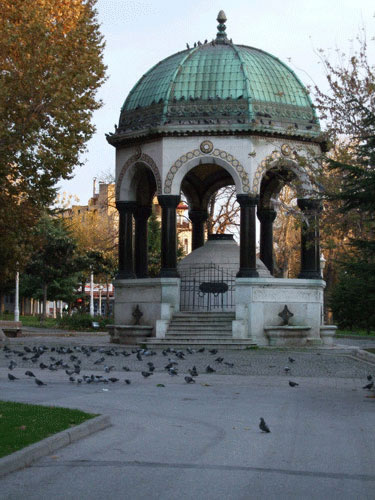FOUNTAIN OF WILHELM THE 2ND

The idea of Great Palace of Constantinople's Empire Lodge (Kathisma) being on the site of the German Fountain's, conflicts with the view that Carceres Gates of Hippodrome was found on the site of the fountain however, the hypothesis of Carceres Gates being on the site enforces the view that Quadriga of Lysippos was used to stand on the site of the German Fountain.
During his reign, German Emperor and King of Prussia, Wilhelm II visited several European and Eastern countries. His trip started in Istanbul, Ottoman Empire on October 18, 1898 during the reign of Abdülhamid II.] According to Peter Hopkirk, the visit to Ottoman Empire was an ego trip and also had long-term motivations The Emperor's primary motivation for visiting was to construct the Baghdad Railway, which would run from Berlin to the Persian Gulf, and would further connect to British India through Persia. This railway could provide a short and quick route from Europe to Asia, and could carry German exports, troops and artillery. At the time, the Ottoman Empire could not afford such a railway, and Abdülhamid II was grateful to Wilhelm's offer, but was suspicious over the German motives.
Abdülhamid II's secret service believed that German archeologists in the Emperor's retinue were in fac geologists with designs on the oil wealth of the Ottoman empire. Later, the secret service uncovered a German report, which noted that the oilfields in Mosul, northern Mesopotamia were richer than that in the Caucuses. In his first visit, Wilhelm secured the sale of German-made rifles to Ottoman Army, and in his second visit he secured a promise for German companies to construct the Istanbul-Baghdad railway. The German Government constructed the German Fountain for Wilhelm II and Empress Augusta's 1898 Istanbul visit. According to Afife Batur, the fountain's plans were drawn by architect Spitta and constructed by architect Schoele, also German architect Carlitzik and Italian architect Joseph Anthony worked on this project.
According to the Ottoman inscription, the fountain's construction started in the Hejira 1319 (1898-1899), although inauguration of fountain was planned to take place on September 1, 1900-the 25th anniversary of Abdülhamid II's ascension to the throne. Construction, however, could not finish at the planned time and it was instead inaugurated on January 27, 1901 which was Wilhelm II's birthdate. Marble, stone and gem parts of the fountain were constructed in Germany and transported piece by piece to Istanbul by ships.